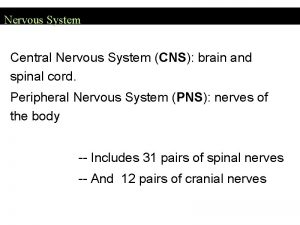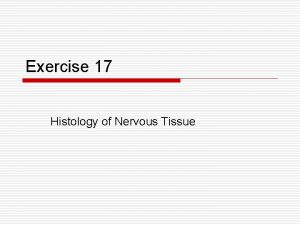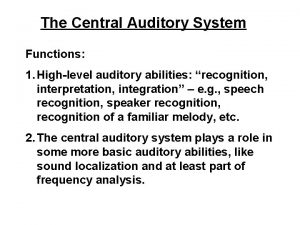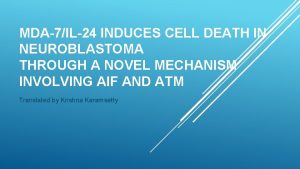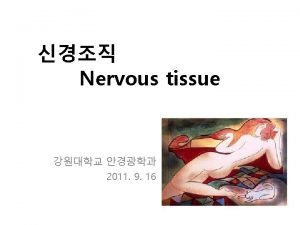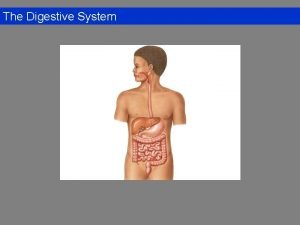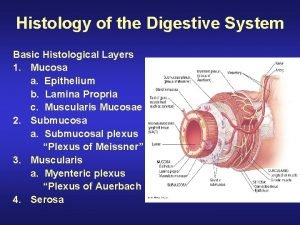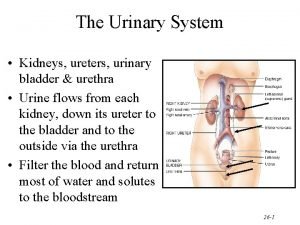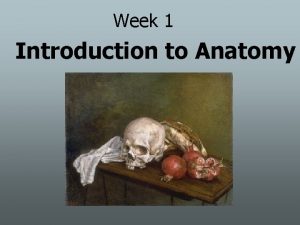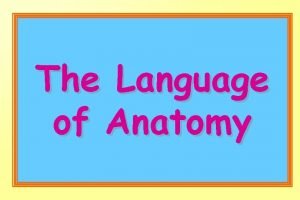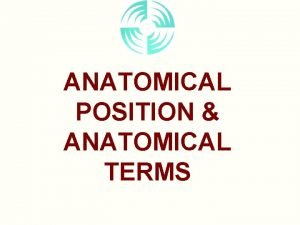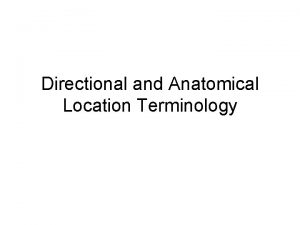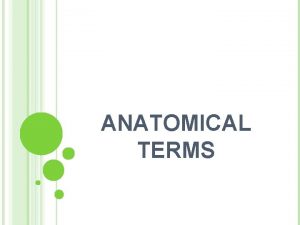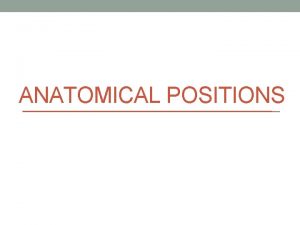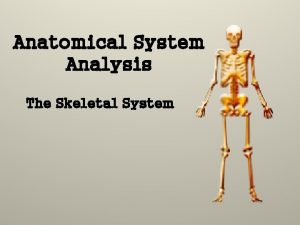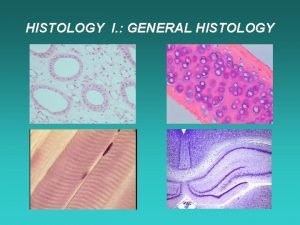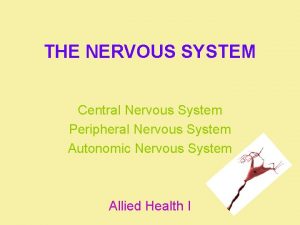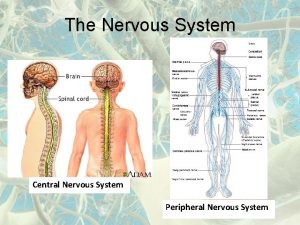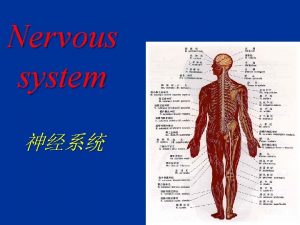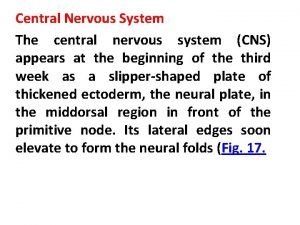Histology of Nervous System Anatomical Division Central Nervous





































- Slides: 37

Histology of Nervous System Anatomical Division: Central Nervous System: Brain & Spinal Cord. Peripheral Nervous System: Axons, Spinal Nerves, Cranial Nerves & Ganglia


Nervous Tissue Functions Receive/Analyze/Integrate-External & Internal Stimuli Response in Effector Organs

Nervous Tissue • Controls and integrates all body activities that maintain life • Three basic functions 1. sensing changes with sensory receptors 2. interpreting and remembering those changes 3. reacting to those changes with effectors 5

Organization Sensory Integration SNS (Motor) SNS (Sensory) ANS (Sensory) Brain Spinal cord ENS (Sensory) 6 Motor ANS (Motor)

Gray and White Matter • White matter = myelinated processes (white in color) • Gray matter = nerve cell bodies, dendrites, axon terminals, bundles of unmyelinated axons and neuroglia (gray color) 7

Neurons Functional unit of nervous system • 1. Cell body a) Nissl bodies (r. ER) b) Neurofilaments c) Microtubules d) Lipofuscin pigment clumps 2. Cell processes a) Dendrites b) A single Axons 8

Electron Microscopy One of My Research/Published Light-Stained Purkinje Neurons

Dendrites • Conducts Impulses Towards The Cell Body • Typically short, highly branched & unmyelinated • Surfaces specialized for contact with other neurons • Contains neurofibrils & Nissl bodies (r. ER) 12 impulse

Axons • Conduct impulses Away From Cell Body • Long, thin cylindrical process of cell • Arises at Axon Hillock • Impulses arise from initial segment (Trigger Zone) • Side branches (collaterals) end in fine processes called Axon Terminals • Swollen tips called synaptic end bulbs contain vesicles filled with Neurotransmitters ((Neuromuscular Junction) 13

Axon (Peripheral Nerve) • Peripheral nerves contain a considerable amount of connective tissue. The entire nerve is surrounded by a thick layer of dense connective tissue, the epineurium. Nerve fibres are frequently grouped into distinct bundles, fascicles, within the nerve. The layer of connective tissue surrounding the individual bundles is called perineurium. The perineurium is formed by several layers of flattened cells, which maintain the appropriate microenvironment for the nerve fibres surrounded by them. The space between individual nerve fibres is filled by loose connective tissue, the endoneurium. 14

Axons 15

Structural Classification of Neurons Based on number of processes found on cell body 1. Multipolar = several dendrites & one axon • most common cell type 2. Bipolar Neurons = one main dendrite & one axon • found in retina, inner ear & olfactory 3. Unipolar Neurons = one process only(develops from a bipolar) • are always sensory neurons • 17

Structural Classification of Neurons Based on number of processes found on cell body 1. multipolar = several dendrites & one axon • most common cell type 2. bipolar neurons = one main dendrite & one axon • found in retina, inner ear & olfactory 3. unipolar neurons = one process only(develops from a bipolar) • are always sensory neurons • 18

Structural Classification of Neurons Based on number of processes found on cell body 1. Multipolar Neurons= several dendrites & one axon • most common cell type; Motor Neuron 2. Bipolar Neurons = one main dendrite & one axon • found in retina, inner ear & olfactory (Special Senses) 3. Unipolar Neurons = one process only(develops from a bipolar) • are always Sensory Neurons • 19

Neuroglial Cells Structural Support Cells Half of the volume of the CNS Smaller cells than neurons Cells Can Divide – rapid mitosis in tumor formation (Gliomas) • • • 4 cell types in CNS – astrocytes, oligodendrocytes, microglia & ependymal • 2 cell types in PNS – schwann and satellite cells 20

Neuroglial Cells (CNS): Astrocytes • Star-shaped cells • Form Blood-brain Barrier Forms Perivascular Feet by covering blood capillaries • Metabolize neurotransmitters • Regulate K+ balance • Provide structural support 21

Neuroglial Cells (CNS): Oligodendrocytes • Most common glial cell type • Each forms Myelin Sheath around more than one axons in CNS • Analogous to Schwann cells of PNS 22

Neuroglial Cells (CNS): Microglia • Small cells found near blood vessels • Phagocytic Cell – • Derived macrophages & monocytes 23

Neuroglial Cells (CNS): Ependymal cells • Form epithelial membrane lining cerebral cavities & central canal • Produce Cerebrospinal Fluid (CSF) 24

Neuroglial Cells (PNS): Satellite Cells • Flat cells surrounding neuronal cell bodies in peripheral ganglia • Support Neurons In The PNS Ganglia 25

Spinal Ganglia • Sympathetic Ganglia Cell bodies Lie on posterior Nerve Root of Spinal Cord. • Have Sensory Neurons (Unipolar). • Seen Closely • Multipolar Type: Hence Many Dendrites Hence Widely Apart.

Ganglia • Ganglia Are Masses Of Neuronal Somas, Usually Defined As Being Outside The Central Nervous System. They Seem To Act As Coordinating Way Stations. • Two type Ganglia: • 1. Sensory. 2. Autonomic 27

Anatomy of Autonomic (In. Voluntary) Motor Pathways • In Somatic System One Neuron in CNS connected to effector Organ) • ANS Posses 2 -Neurons between CNS & Effector Organ i. e: • 1. Preganglionic neuron: Lie in CNS, axons Synapse with Multipolar Neuron that is PGN (Acetylcholine) • 2. Postganglionic neuron (PGN): Fibers Connect To Effector Organ (Cardiac, Smooth Muscles & Glands. (Norepinephrine) • Two divisions: • Sympathetic: Prepare Body ((Flight or Fight)) • Parasympathetic: Opposite Function ((Rest or Digest)) 28

29

30


Neuroglial Cells (PNS): Schwann Cell • Cells encircling PNS axons • Each cell produces part of the myelin sheath surrounding an axon in the PNS 32

Myelination • Insulation of axon • Increase speed of nerve impulse

Myelination: PNS • All axons surrounded by a lipid & protein covering (Myelin Sheath) produced by Schwann cells • Neurilemma is fused layers of membranes of Schwann cell – gaps called nodes of Ranvier • Myelinated fibers • Unmyelinated fibers Node of Ranvier

Myelination: CNS • Oligodendrocytes myelinate axons in the CNS • Broad, flat cell processes wrap about CNS axons. One Oligo Can Myelinate Upto 50 Nerves. • Schwan Cell: PNS • Many Schwan Cells Myelinate One Peripheral Nerve • End of one Schwan Segment Node of Ranvier 35

Myelination Process

Electrical Signals in Neurons • • • 37 Neurons are electrically excitable due to the voltage difference across their membrane Communicate with 2 types of electric signals 1. action potentials that can travel long distances 2. graded potentials that are local membrane changes only In living cells, a flow of ions occurs Through Ion Channels In The Cell Membrane

Continuous versus Saltatory 1. Continuous Conduction conduction (unmyelinated fibers) 2. Saltatory conduction (myelinated fibers) 39 Na Na Na A. P.

Saltatory Conduction • Nerve impulse conduction in which the impulse Jumps (Salta) from node to node Na Na Na 40 A. P.

Signal Transmission at Synapses • 41 2 Types of synapses 1. Electrical • ionic current spreads to next cell through gap junctions • faster, two-way transmission & capable of synchronizing groups of neurons 2. Chemical • one-way information transfer from a presynaptic neuron to a postsynaptic neuron – axodendritic -- from axon to dendrite – axosomatic -- from axon to cell body – axoaxonic -- from axon to axon

Synapses
 Central and peripheral nervous system
Central and peripheral nervous system Ppt
Ppt Neuron process
Neuron process Fundamentals of the nervous system and nervous tissue
Fundamentals of the nervous system and nervous tissue What are neuron processes
What are neuron processes Major division of nervous system
Major division of nervous system Label the parts of the main divisions of the nervous system
Label the parts of the main divisions of the nervous system Sheep brain labeled
Sheep brain labeled Central nervous system amusement park
Central nervous system amusement park Brain nervous system
Brain nervous system Nervous tissue
Nervous tissue Central and peripheral nervous system
Central and peripheral nervous system Bser aer
Bser aer Electrical synapse vs chemical synapse
Electrical synapse vs chemical synapse Central nervous system for kids
Central nervous system for kids Anatomical structure of urinary system
Anatomical structure of urinary system Nervous system and digestive system
Nervous system and digestive system Endocrine system and nervous system
Endocrine system and nervous system Endo crine gland
Endo crine gland Adh function
Adh function Central nervous sysytem
Central nervous sysytem Long division and short division
Long division and short division Synthetic division of polynomials
Synthetic division of polynomials Method of hcf
Method of hcf Synthetic dividion
Synthetic dividion Serosa vs adventitia
Serosa vs adventitia Bronchus histology
Bronchus histology Histology digestive system
Histology digestive system Digestive system histology
Digestive system histology Digestive system histology
Digestive system histology Integumentary system histology labeled
Integumentary system histology labeled Urinary bladder
Urinary bladder Respiratory system histology
Respiratory system histology Renal lobe and lobule
Renal lobe and lobule Broncheoli
Broncheoli Regional terms anatomy
Regional terms anatomy Uniform anatomical gift act
Uniform anatomical gift act Body erect
Body erect






